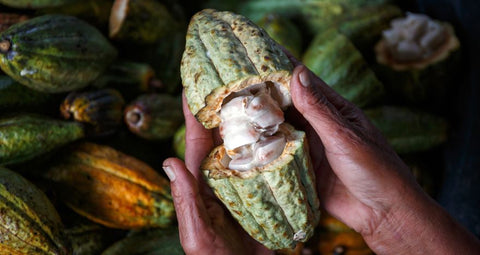Cacao is the source of one of the world’s most decadent and beloved flavors—chocolate! It offers a rich and complex taste that melts in your mouth and makes you crave more. Aside from its mouthwatering flavor, cacao also wins hearts with its versatility—from comforting hot chocolate to creamy chocolate spreads—and high antioxidant content.
This bean’s ascent from the ancient Mesoamerican civilizations as currency to its omnipresence in today’s kitchens and cafes signifies cacao’s unmatched value. As a luxurious commodity, sustainable sourcing is key to preserving cacao resources, ensuring we have plenty to relish for years to come. Check out our ultimate guide to sustainable cacao sourcing and uncover how this practice enhances the taste and value of chocolatey goodness.
What is Sustainable Sourcing?
Sustainable sourcing ensures we meet our current needs while preserving resources for future generations. When we talk about sustainable cacao sourcing, it means making sure the way we get the resource is good for the planet, fair to the people involved, and makes economic sense for the long haul.
But what does that really entail? Each phase, from tree nurturing and harvesting to creating a chocolatey treat, must harmoniously balance human interests, wildlife preservation, and the environment. Sustainable sourcing is a holistic process that:
- Champions fair wages
- Enforces labor regulations
- Protects biodiversity and natural habitats
- Invests in local communities
The Difference Between Sustainable and Unsustainable Sourcing
Unsustainable cacao sourcing typically involves issues like deforestation, child labor, and exploitation of farmers. This can cause a devastating ecological footprint and unjust social welfare. On the flip side, sustainable sourcing cultivates ethical and fair trade practices, organic farming, support for local communities, and environmental conservation.
Sustainable sourcing also highlights transparency and certification. If you can trace your chocolate treat back to a farm and ensure it aligns with environmental and ethical standards, it likely comes from sustainable sourcing.
How to Support Cacao Sustainability
Did you know you can play an important role in cacao sustainability? Whenever you purchase a product with sustainably sourced cacao ingredients, you’re casting a vote of support for sustainability. Some distinguished indicators and information to look for when supporting sustainably sourced cacao products include:
Product Origins
Knowing where your cacao comes from allows you to dig into the farming practices of that specific farm, cooperative, or general location. Location origins can give you insight into farming methods that minimize harm to the environment and social aspects, such as fair wages, safe working conditions, and prohibition of child labor.
Cacao Sourcing From Africa
Africa, particularly the Ivory Coast and Ghana, leads in global cacao production. However, they struggle with sustainability challenges such as deforestation, labor exploitation, including prevalent child labor, and persistent poverty within farming communities. These issues not only harm biodiversity and contribute to climate change but also trap people in a cycle of poverty.
The volatility of global cacao prices exacerbates these problems, preventing farmers from earning a living wage and investing in sustainable and ethical practices. This situation highlights a pressing need for reforms that promote environmental conservation, fair labor practices, and economic stability for farming communities across the continent.
Cacao Sourcing From Latin America
In contrast, Latin America stands as a sustainability leader in the cacao industry. Countries like Ecuador, Peru, and the Dominican Republic lead by integrating eco-friendly farming practices. This includes protecting the soil they use and avoiding the use of chemicals that are harmful to the environment.
Another common practice among Latin American cacao farmers is agroforestry. Cacao trees can thrive alongside diverse plant species, supporting wildlife, preventing soil erosion, and maintaining water cycles. Fair trade certifications are also widespread in Latin America, ensuring farmers receive fair pay that promotes community development and sustainable livelihoods.
Latin America’s dual focus on ethical practices and environmental stewardship positions it as a model for sustainable and equitable cacao sourcing. Artisana Market uses ethically and sustainably sourced cacao from Latin America to craft our raw cacao spreads. As such, investing in and using our cacao spreads demonstrates your personal support for cacao sustainability.
Verified Certifications
Certifications are crucial for steering consumers towards ethically produced chocolate. USDA Organic certifications highlight organic farming methods that support sustainability by banning harmful synthetic pesticides and fertilizers. While it focuses mainly on production methods, it's a step towards environmental sustainability.
Other recognized certifications that are passports to the world of sustainability include Fair Trade, Rainforest Alliance, and UTZ logos. They indicate products meet certain environmental, social, and economic standards.
The Benefits of Sustainable Cacao Sourcing
Sustainable cacao sourcing yields a rich tapestry of benefits that make your chocolate treats all the more enjoyable. Such benefits of sustainable sourcing include:
Environmental Preservation
Sustainable cacao sourcing places high value on preserving the natural ecosystems where cacao is grown. The organic and regenerative farming methods used to grow cacao minimize the use of harmful pesticides and chemicals, curbing the potential for water and soil pollution. Sustainable cacao sourcing also champions shade-grown cacao, which cultivates better-quality beans and supports biodiversity by maintaining a more natural habitat.
Support for Farmers and Communities
A key tenet of sustainable sourcing is the uplifting of the farming communities that grow cacao. Supporting cacao farmers and their families ensures fair wages, enriches local economies, reduces poverty, and sustains community development.
High Quality and Traceability
Sustainably sourced cacao leads to better products. The care taken in all aspects of the production process, from the tree to the bean, typically results in a richer, more flavorful chocolate. Additionally, the meticulous traceability of each batch fosters a deeper connection between the consumer and the cacao’s heritage, fostering a greater appreciation for the product.
Ethical Labor Practices
Sustainable sourcing necessitates fair and ethical labor standards, such as strict prohibition of child labor and safe, healthy working conditions for all involved in the cacao supply chain. It promotes dignity, respect, and safety for workers while upholding their rights.
Sustainable cacao sourcing is an exquisite indulgence and a profound commitment to global well-being. With this guide to sustainable cacao sourcing, you can enhance your role in this beneficial movement and support such practices. Chocolate delights taste ten times better when you savor them with a clear conscience.



